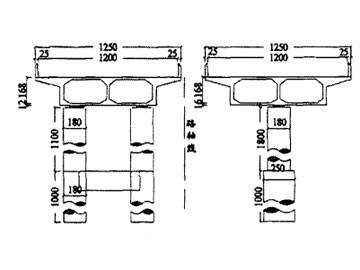Bridge Maintenance
Carbon Fiber Reinforcement
Carbon fiber reinforcement technology in bridge repair and maintenance has significantly improved the quality of bridge reinforcement construction, saved the cost of bridge repair and maintenance, and has high economic and social benefits.
Project
Taking an expressway as an example, a certain section of the bridge is divided into left and right bridges, of which the left bridge is 387m long, 12.5m wide, and the right bridge is 447m long and 13m wide. The main girder of the bridge is a cast-in-place concrete continuous box girder. The box girder is a single-box double-chamber section. The thickness of the top plate is about 200mm and the thickness of the bottom plate is about 180mm. Through a comprehensive inspection of the bridge, it was found that there were many cracks in the bridge, and the phenomenon of concrete damaged and exposed bars. The largest vertical crack width was about 0.28mm, and the diagonal crack width was 0.5mm.

Bridge hazard risk
The bridge adopts a reinforced concrete structure, so it is easy to have transverse cracks at the bottom plate. However, as long as the width of the cracks does not exceed the requirements of the standard specifications, the normal operation of the bridge will not be affected. However, from the field test results, the maximum crack width of the box girder is about 0.5 mm, and there are a large number of cracks that exceed the upper limit of 0.20 mm. This shows that the flexural bearing capacity of the front section of the bridge itself is lacking, and it is more susceptible to the influence of external water. This leads to local corrosion of the steel bars in the concrete, which reduces the structural durability of the bridge itself, and causes the bridge itself to have serious safety hazards. Therefore, effective maintenance measures must be taken to strengthen the bridge.
Reinforcement construction plan
(I) For cracks with crack width less than 0.15mm and shallow depth, use resin sealant to strengthen them;
(2) For the crack width higher than O. For cracks of 15mm and less than 0.5mm, it needs to be treated with crack filling glue or epoxy resin grout.
(3) For cracks with a crack width exceeding 0.5mm, the cracks need to be slotted and embedded.
(4) For all cracks, combine the width and position of the cracks, and stick the carbon fiber cloth along the direction of the tensile stress.
Application of Carbon Fiber Reinforcement Technology in Bridge Maintenance
Clean up the diseased area
(1) Aiming at the concrete pockmarked, loose, broken or peeling phenomenon in some areas, this project adopts manual cutting method, high-speed water jetting method and other methods. Clean the dirty and damaged areas on the concrete surface until the base surface is exposed. During the whole treatment process, damage to the original steel bars of the beam should be avoided.
(2) For some corrosion areas of steel bars, after cleaning the floating rust on the surface of the steel bars, apply a layer of steel protection agent to improve the corrosion resistance of the steel bars. During the construction process, pay special attention to the high permeability of the multifunctional rust inhibitor itself, and the relevant construction personnel should strictly prohibit direct contact with it to avoid dripping on the body or skin.
Crack treatment
According to the established bridge repair and maintenance measures, different treatment methods are adopted for the different crack widths. During the entire crack repair stage, before the material has hardened, it is strictly forbidden for the bridge to bear loads beyond its own weight and necessary construction equipment. The epoxy resin slurry, resin wind comparison or crack infusion glue are all used for construction by pressure infusion. During the specific construction process, it is necessary to ensure that the pressure is always stable during the entire injection process, to ensure that the repair material is injected to the end of the crack, and the air accumulated in the crack is expelled into the capillary pores of the concrete, and the natural breathing of the concrete is used to remove it.
Carbon fiber reinforcement construction
(1) The choice of carbon fiber materials.
(2) Before construction, measure the ambient temperature and the surface moisture content of the concrete to ensure that the ambient temperature is not lower than 5℃ and the surface moisture content of the concrete is not higher than 4%. At the same time, effective measures need to be taken to clean the surface of the concrete cracks, and the surface flatness after repairing reaches 5mm/m.
(3) Glue the bottom layer.
(4) Leveling materials
(5) Carbon fiber cloth impregnated with resin
Concluding remarks
In summary, the application of carbon fiber reinforcement technology in bridge repair and maintenance has significantly improved the quality of bridge reinforcement construction, saved the cost of bridge repair and maintenance, and has high economic and social benefits.